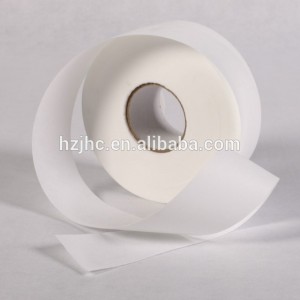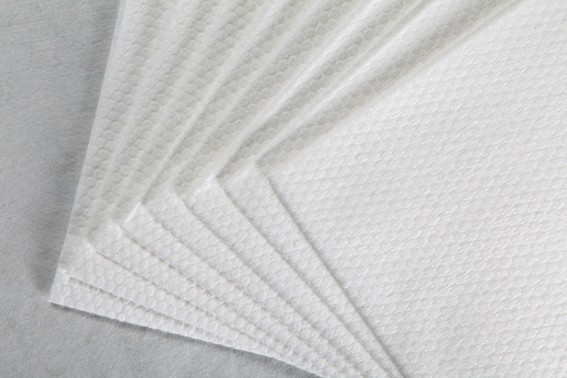What is the difference between spunlaced nonwovens and spunbonded nonwovens, and what are the main features? Today, let's find out about it.
Spunlaced nonwovens concept: spunlaced nonwovens, also known as spunlaced nonwovens, also known as "jet net into cloth". The concept of "forming cloth with jet spray net" comes from mechanical acupuncture technology. The so-called "jet net" is the use of high-pressure water to pierce into the fiber net, so that the fibers wind each other, so that the original spunlaced nonwovens to loose fiber net has a certain strength and complete structure.
Its technological process is
Fiber metering mixing-loosening and impurity removal-mechanical messy carding into a net-pre-wetting of fiber mesh-water needle entanglement-surface treatment-drying-coiling-inspection-packaging into storage.
The jet net-spraying device uses the high-pressure water flow of high-speed spunlaced non-woven fabric manufacturers to make the fibers in the fiber net rearrange, wind each other, and become a non-woven fabric with complete structure and certain strength and other properties. The physical properties of this spunlaced nonwoven bag are different from those of common needle-punched nonwovens, and they are the only nonwovens that can make the final product similar to textiles in terms of handle and properties of ultra-fine fiber nonwovens.
The superiority of spunlace
There is no extrusion of the fiber web in the spunlacing process, thus improving the swelling of the final product; the inherent softness of the fiber net is maintained without the use of resin or adhesive; the high integrity of the product avoids the fluffy phenomenon of the product; the fiber web has a high mechanical strength, up to 80%-90% of the textile strength; the fiber web can be mixed with any variety of fibers. In particular, it is worth mentioning that the spunlaced fiber net can be compounded with any base cloth to make a composite product. Products with various functions can be produced according to different uses.
Advantages of spunlaced cloth:
1. Soft and good drape.
2. Good strength.
3. It has high hygroscopicity and fast hygroscopicity.
4. Low fuzz.
5. Washability.
6. No chemical additives.
7. The appearance is similar to that of textiles.
The prospect of spunlaced cloth
Due to the advantages of spunlaced cloth, it has become the fastest technological progress in the non-manufacturing industry in recent years. The development direction of nonwovens is to replace textiles and knitted goods. Spunlaced fabric has become the most potential field to compete with the textile market because of its most textile-like characteristics, excellent physical properties, high quality and low price. .
Application of spunlaced cloth
1. Medical use of disposable surgical clothes, surgical covers, operating table cloths, surgical aprons, wound patches, bandages, gauze, band-aids, etc.
2. Clothing categories such as clothing interlining, baby clothing, training clothing, carnival night disposable color clothing, all kinds of protective clothing such as surgical clothes, etc.
3. Wiping towels such as household, personal, cosmetic, industrial, medical dry and wet towels, etc.
4. Decorative cloth such as car interior, home interior, stage decoration, etc.
5. Agricultural products such as heat preservation greenhouse, anti-weed growth, bumper harvest cloth, insect-proof and fresh-keeping cloth, etc.
6. Spunlaced nonwovens can also be used for composite processing to produce products with "sandwiches" structure and develop new composite materials for various uses. .
Spunbonded nonwovens
After the polymer is extruded and stretched to form a continuous filament, the filament is laid into a net, and then through its own bonding, thermal bonding, chemical bonding or mechanical reinforcement, the network becomes non-woven.
Features: high strength, good high-temperature resistance (can be used in 150 ℃ environments for a long time), aging resistance, UV resistance, high elongation, good stability and air permeability, corrosion resistance, sound insulation, mothproof, non-toxic. Main uses: the main products of spun-bonded nonwovens are polypropylene polyester (long fiber, staple fiber). The most common and commonly used applications are non-woven bags, non-woven packaging and so on, and they are also easy to identify. because the rolling point of spun-bonded nonwovens is diamond.
The above is the introduction of the difference between spunlaced nonwovens and spun-bonded nonwovens. If you want to know more about spunlaced nonwovens, please feel free to contact us.
More from Our Portfolio
Read more news
1. What is the difference between spunlaced nonwovens and spunbonded nonwovens
2. what is a spunlace nonwoven
3. Standard for testing spunlaced non-woven fabrics
4. What is the difference between spunlaced nonwovens and spunbonded nonwovens
5. What if the composite fabric is delaminated
6. Spunlaced nonwovens industry is in a period of prosperity
Post time: Feb-16-2022



